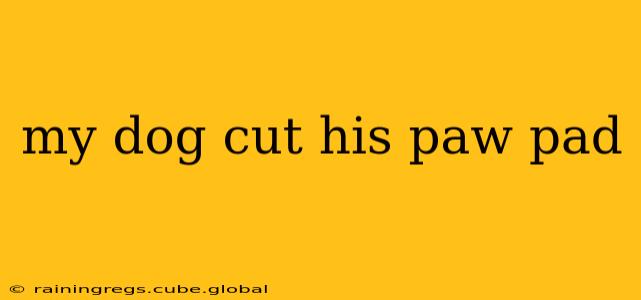Has your furry friend suffered a paw pad injury? A cut paw pad is a common problem for dogs, often causing significant discomfort and limiting their mobility. This comprehensive guide will walk you through identifying the severity of the injury, providing first aid, and understanding when professional veterinary care is necessary. We'll also explore preventative measures to keep your dog's paws healthy and happy.
How Serious is My Dog's Paw Pad Cut?
The severity of a paw pad cut varies greatly. Minor cuts may only require basic first aid at home, while deeper wounds or those involving embedded debris necessitate a veterinary visit. Consider these factors:
- Depth of the cut: Superficial scratches heal quickly, but deeper cuts may expose underlying tissue and require stitches.
- Bleeding: Minor bleeding is normal, but excessive bleeding indicates a more serious injury.
- Presence of debris: Dirt, gravel, or glass embedded in the wound can cause infection.
- Signs of infection: Increased swelling, redness, pus, or limping beyond a day or two suggests infection.
What Should I Do If My Dog Cuts His Paw Pad?
Immediate action is crucial. Follow these steps for first aid:
- Examine the wound: Carefully assess the depth and extent of the injury. Remove any visible debris with tweezers, being gentle to avoid causing further damage.
- Control bleeding: Apply gentle pressure with a clean cloth or gauze for several minutes. If bleeding is excessive or doesn't stop, seek immediate veterinary care.
- Clean the wound: Gently rinse the wound with clean, lukewarm water. Avoid using hydrogen peroxide or antiseptic solutions, as these can damage the tissue.
- Apply a bandage (if necessary): For deeper cuts, a clean bandage can help protect the wound and prevent further injury. Ensure the bandage is not too tight, restricting blood flow. Consider using a product designed for pet paw wounds.
- Monitor your dog: Watch for signs of infection, such as swelling, redness, pus, or increased pain. If any of these develop, contact your vet immediately.
When Should I Take My Dog to the Vet?
It's always best to err on the side of caution. Consult your veterinarian if:
- Bleeding is excessive or uncontrolled.
- The cut is deep and involves underlying tissue.
- Debris is embedded in the wound and cannot be easily removed.
- Your dog is showing signs of pain or discomfort.
- The wound shows signs of infection (swelling, redness, pus).
- Your dog is licking or chewing the wound excessively.
How Long Does It Take for a Dog's Paw Pad to Heal?
Healing time depends on the severity of the injury. Minor scratches may heal within a few days, while deeper cuts can take several weeks. Keep the wound clean and dry, and follow your veterinarian's instructions for aftercare.
How Can I Prevent My Dog from Cutting His Paw Pads?
Prevention is key! Here are some helpful tips:
- Trim your dog's nails regularly: Long nails can make them more prone to injury.
- Avoid walking your dog on hot surfaces: Asphalt and pavement can burn paw pads.
- Protect your dog's paws in harsh conditions: Use booties or paw wax during winter or when walking on rough terrain.
- Inspect your dog's paws regularly: Catch small cuts or injuries early to prevent complications.
- Be mindful of sharp objects and debris: Keep your yard and walking areas clear of potential hazards.
What are Some Home Remedies for Minor Paw Pad Cuts?
For minor cuts, applying a small amount of pet-safe balm can aid healing and soothe irritation. Aloe vera gel (ensure it’s pure and not diluted with additives) can also provide some relief and promote healing in small wounds. Never use human medications or remedies on your pet without consulting your veterinarian.
My Dog is Licking His Paw Pad Excessively – Is This Normal?
Excessive licking can indicate pain, irritation, or infection. While some licking is normal, persistent licking warrants a veterinary examination. A cone or Elizabethan collar may be necessary to prevent your dog from further injuring the paw pad.
Remember, this information is for general guidance only. Always consult your veterinarian for diagnosis and treatment of your dog's paw pad injury. They can assess the specific needs of your pet and provide appropriate care.
